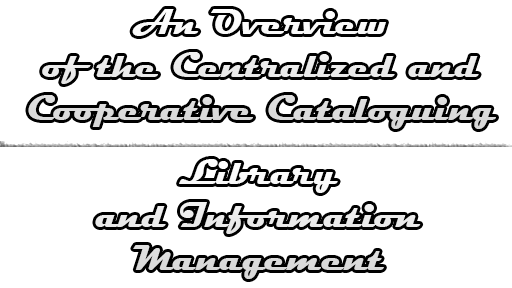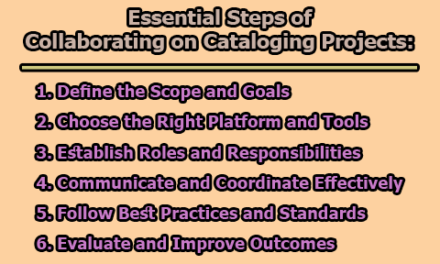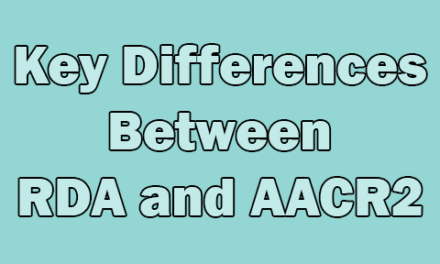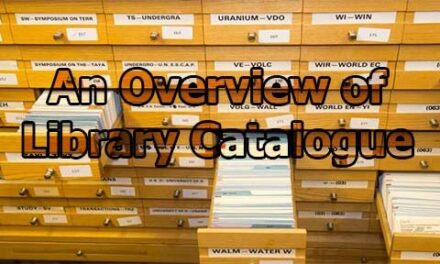An Overview of the Centralized and Cooperative Cataloguing:
Centralized and cooperative cataloguing are two approaches used in the creation and maintenance of library catalogues. Cataloguing is the process of creating records for library materials, such as books, videos, and other items, in order to provide users with a comprehensive and organized list of available resources. In the rest of this article, we are going to make an overview of the centralized and cooperative cataloguing.
Definitions of Centralized Cataloguing:
The various authorities of library science have defined Centralized Cataloguing. Some definitions are as follows:
According to G. E. Gorman, “Centralized cataloguing refers to the practice of cataloguing material at a central point, from which cataloguing data are distributed to other libraries for use in their own catalogues.”
In the words of S. R. Ranganathan, “Centralized cataloguing is the organization of cataloguing work so as to concentrate it in a central agency, with the aim of achieving maximum efficiency in cataloguing output and thereby contributing to the development of library service.”
According to C. C. Fikar and A. J. Jenkins, “Centralized cataloguing refers to the cataloguing of library materials by a central agency, usually a national library or a specialized cataloguing centre, with the purpose of producing standardized bibliographic records that can be shared by many libraries.”
In the opinion of Robert P. Holley, “Centralized cataloguing is the creation of bibliographic records for library materials in a single location, usually a central library or a specialized cataloguing agency, which are then distributed to other libraries for use in their local catalogues.”
As defined by M. H. Yamin, “Centralized cataloguing is a method of cataloguing whereby a central organization undertakes to prepare the cataloguing records for all materials acquired by a number of participating libraries, which are then distributed to the participating libraries to be incorporated in their own catalogues.”
From the above definitions, we can say that centralized cataloguing involves creating bibliographic records for library materials in a single location or by a central agency, which are then shared with other libraries for use in their local catalogues.
Definitions of Cooperative Cataloguing:
Some definitions are as follows:
According to Martha M. Yee, “Cooperative cataloguing is a collaborative process in which libraries work together to create and share bibliographic records for library materials, with the goal of providing users with access to a larger and more comprehensive collection of resources.”
In the words of Karen Calhoun, “Cooperative cataloguing is the process by which libraries work together to create and maintain a shared catalogue, allowing them to share resources and reduce duplication of effort.”
According to R. S. Ranganathan, “Cooperative cataloguing involves the participation of a number of libraries in a common enterprise, the preparation of a union catalogue, and the exchange of information concerning their collections.”
In the opinion of Jay Jordan, “Cooperative cataloguing is the act of creating a shared catalogue that provides the ability to share resources across multiple libraries, enabling libraries to provide broader access to collections while also improving the efficiency of cataloguing.”
As defined by William J. Wheeler, “Cooperative cataloguing involves the coordinated cataloguing of materials by multiple libraries or cataloguing agencies, in order to produce standardized bibliographic records that can be shared by many libraries.”
The definitions given above allow us to conclude that cooperative cataloguing involves libraries or cataloguing agencies working together to create and maintain a shared catalogue, allowing them to share resources, reduce duplication of effort, and provide users with access to a larger and more comprehensive collection of resources.
Objectives of Centralized Cataloguing:
Centralized cataloguing has several objectives, which include:
- To avoid duplication of work: Centralized cataloguing helps to avoid duplication of cataloguing work by allowing libraries to share cataloguing records. This reduces the workload for individual libraries and ensures that cataloguing resources are used more efficiently.
- To reduce the cost of cataloguing: By sharing cataloguing records, centralized cataloguing can help to reduce the cost of cataloguing for individual libraries. This is especially beneficial for smaller libraries with limited resources.
- To achieve uniformity in classification and cataloguing practices: Centralized cataloguing helps to ensure that all cataloguing records are created using the same classification and cataloguing practices, which promotes consistency and standardization across libraries.
- To raise the level of quality of cataloguing: By concentrating cataloguing work in a central location, centralized cataloguing can help to ensure that cataloguing records are created to a high standard of quality.
- To put catalogers to more effective use: Centralized cataloguing can help to put cataloguers to more effective use by allowing them to focus on cataloguing materials that are unique to their library or require special attention.
- To enable member libraries to provide better service to users: By sharing cataloguing records, centralized cataloguing can help member libraries provide better service to their users by giving them access to a larger and more comprehensive catalogue of resources.
- To make the most effective use of the cataloguing personnel: Centralized cataloguing enables cataloguing personnel to work more efficiently by allowing them to focus on creating high-quality cataloguing records.
- To promote the uniformity of cataloguing and catalogues: By ensuring that all cataloguing records are created using the same classification and cataloguing practices, centralized cataloguing can promote uniformity in cataloguing and catalogues.
- To provide better and more effective library services: Ultimately, the objective of centralized cataloguing is to provide better and more effective library services to users by creating a more comprehensive, consistent, and standardized catalogue of library resources.
Objectives of Cooperative Cataloguing:
The main objectives of cooperative cataloguing include:
- To reduce duplication of effort: Cooperative cataloguing allows libraries to share bibliographic records and reduce the amount of effort required for individual libraries to create their own records.
- To improve access to information: By sharing cataloguing records, cooperative cataloguing can improve access to information and resources by making them available to a larger audience.
- To promote standardization: Cooperative cataloguing promotes standardization of cataloguing practices and ensures that records are created using the same standards and guidelines.
- To improve efficiency: Cooperative cataloguing can improve efficiency by enabling libraries to share the workload of creating bibliographic records and reducing the amount of time and resources required for cataloguing.
- To provide better service to users: By creating a more comprehensive, consistent, and standardized catalogue of library resources, cooperative cataloguing can provide better service to users by making it easier for them to find and access the materials they need.
- To promote resource sharing: Cooperative cataloguing encourages resource sharing among libraries and enables libraries to expand their collections by sharing materials with other libraries.
- To reduce costs: By sharing cataloguing records and resources, cooperative cataloguing can reduce costs for individual libraries and enable them to allocate their resources more effectively.
- To facilitate interlibrary loans: Cooperative cataloguing can facilitate interlibrary loans by making it easier for libraries to identify and request materials from other libraries.
Forms of Centralized Cataloguing:
Centralized cataloguing is a process used in libraries to create consistent and standardized cataloguing records. Here are some forms of centralized cataloguing:
- Card (or sheaf) service: This system was commonly used before the widespread use of computers and electronic databases. Cataloguers would create bibliographic records on index cards or sheaves of cards, which were then distributed to libraries for filing in their card catalogues. This system allowed for standardized cataloguing records to be shared among libraries, but it was a labour-intensive process that required a lot of manual effort.
- MARC (Machine-Readable Cataloguing) service: This system uses a standardized electronic format for creating bibliographic records, making it possible to share and exchange records between libraries. MARC records are usually created using cataloguing software, which allows cataloguers to input data in a standardized format. The MARC format is widely used in library automation systems, and it has facilitated the exchange of cataloguing data among libraries.
- Information service: This system involves a central organization creating bibliographic records for a variety of materials and distributing them to libraries. This is often done by national library services, such as the Library of Congress in the United States or the British Library in the United Kingdom. The bibliographic records are created using standardized formats, such as MARC, and can include cataloguing information for non-book materials such as audiovisual resources. This system allows for efficient and consistent cataloguing across libraries.
- Cataloguing-in-Source: This is a form of centralized cataloguing in which the publisher provides cataloguing information in the book itself, usually on the copyright page. This system is particularly useful for books that have complex or specialized subject matter, as the publisher can provide expert cataloguing information. Cataloguing-in-Source allows for consistent and high-quality cataloguing records to be created for books.
- Cataloguing-in-Publication: Similar to Cataloguing-in-Source, this system involves the publisher providing cataloguing information in the book. However, in this case, the information is provided before the book is published, allowing libraries to catalogue information in advance of the publication date. This system allows libraries to prepare for the arrival of new materials and can facilitate more efficient cataloguing processes.
- Pre-natal cataloguing: This involves cataloguing materials before they are even published, using advanced information provided by publishers. This allows libraries to have cataloguing information ready for materials as soon as they are available. Pre-natal cataloguing can facilitate more efficient cataloguing processes and can ensure that materials are available to users as soon as possible.
Forms of Cooperative Cataloguing:
Cooperative cataloguing is a process used by libraries to share and exchange bibliographic records. It involves libraries working together to create consistent and standardized cataloguing records for materials. There are several forms of cooperative cataloguing, including:
- National bibliographic agencies: National bibliographic agencies, such as the Library of Congress in the United States or the British Library in the United Kingdom, create bibliographic records for materials published in their respective countries. These agencies use standardized formats, such as MARC, to create records, which are shared with other libraries in the country. This ensures consistent and high-quality cataloguing across libraries.
- Union catalogues: Union catalogues are catalogues that combine bibliographic records from multiple libraries into a single database. This allows users to search for materials across multiple libraries at once. Union catalogues can be national, such as the Library of Congress catalogue, or they can be regional or local. Examples of union catalogues include WorldCat and the Online Computer Library Center (OCLC).
- Shared cataloguing systems: Shared cataloguing systems allow multiple libraries to work together to create and maintain a single catalogue. These systems are often used by libraries that are part of a consortium or network. Libraries in the consortium can add records to the shared catalogue, which can then be accessed by all members of the consortium.
- Cooperative cataloguing networks: Cooperative cataloguing networks, such as the Cataloging in Publication (CIP) program in the United States, involve libraries working together to create cataloguing records for materials. In the CIP program, publishers provide cataloguing information to the Library of Congress, which creates cataloguing records for new materials. These records are then shared with other libraries in the United States, allowing for consistent and efficient cataloguing.
- International cataloguing initiatives: International cataloguing initiatives involve libraries and cataloguing organizations working together to create cataloguing records for materials that are published in multiple countries or in languages other than English. Examples of international cataloguing initiatives include the International Standard Bibliographic Description (ISBD) and the International Federation of Library Associations and Institutions (IFLA) cataloguing rules.
Cooperative cataloguing allows libraries to share resources and reduce the duplication of effort in cataloguing materials. It also ensures consistent and high-quality cataloguing across libraries, which benefits users who are searching for materials.
Centralized Cataloguing Vs Cooperative Cataloguing:
| C.N | Centralized Cataloguing | Cooperative Cataloguing |
| 1. | Cataloguing is done by a central agency or organization | Cataloguing is done by multiple libraries working together |
| 2. | Cataloguing records are created using a standardized format | Cataloguing records are created using a standardized format |
| 3. | Centralized cataloguing is often used for national bibliographies | Cooperative cataloguing is often used for union catalogues |
| 4. | Cataloguing records are distributed to libraries for use | Cataloguing records are shared among libraries in a network |
| 5. | Centralized cataloguing can result in consistent and high-quality cataloguing | Cooperative cataloguing can also result in consistent and high-quality cataloguing |
| 6. | Examples of centralized cataloguing include the Library of Congress cataloguing system and national bibliographic agencies | Examples of cooperative cataloguing include union catalogues and shared cataloguing systems |
| 7. | Centralized cataloguing can be time-consuming and labour-intensive | Cooperative cataloguing can be more efficient and reduce duplication of effort |
| 8. | Centralized cataloguing is often used for materials that are published in a single country or region | Cooperative cataloguing is often used for materials that are shared among multiple libraries or regions |
| 9. | Centralized cataloguing can require a high level of expertise from cataloguers | Cooperative cataloguing can allow for collaboration and sharing of expertise among libraries |
| 10. | Centralized cataloguing can be useful for ensuring consistent cataloguing standards across libraries | Cooperative cataloguing can be useful for improving access to materials by making them available in a shared catalogue |
It is apparent that centralized and cooperative cataloguing are two approaches used by libraries to create and maintain cataloguing records for their collections. Centralized cataloguing involves a central agency or organization creating cataloguing records for materials, while cooperative cataloguing involves multiple libraries working together to create and share cataloguing records. Centralized cataloguing can be useful for ensuring consistent cataloguing standards and providing high-quality cataloguing records to libraries. However, it can be time-consuming and labour-intensive, and may not be suitable for materials that are published in multiple countries or regions. Cooperative cataloguing, on the other hand, can improve access to materials by making them available in shared catalogues and can reduce duplication of effort among libraries. Both approaches have their advantages and are used in different contexts. Libraries may choose to use centralized cataloguing for materials that are published in a single country or region, while cooperative cataloguing may be used for materials that are shared among multiple libraries or regions. Ultimately, the goal of both approaches is to create high-quality cataloguing records that improve access to library materials and enhance the user experience.
References:
- Matthews, J. R. (2004). Centralized cataloguing: past, present, and future. Cataloging & Classification Quarterly, 38(4), 73-88.
- Miksa, F. L. (2010). The evolution of cataloguing: from centralized to decentralized, from physical to digital. Journal of Library Metadata, 10(3-4), 213-223.
- Tseng, S. (2005). Centralized and decentralized cataloguing practices in libraries. Journal of Library and Information Science, 31(2), 121-138.
- Chan, L. M. (2007). Cooperative cataloguing: past, present, and future. Cataloging & Classification Quarterly, 43(4), 7-19.
- Coyle, K. (2012). Cooperative cataloguing: principles and practice. Libraries Unlimited.
- Eby, D. (2005). Cooperative cataloguing: a critical view. Journal of Library Administration, 42(1), 7-21.
- Inaba, M. (2005). Centralized and decentralized cataloguing: a comparison of cataloguing practices in Japan and the United States. Cataloging & Classification Quarterly, 40(2), 61-81.
- Lin, J. (2009). Cooperative cataloguing: principles and benefits. Library Philosophy and Practice, 2009.
- Markey, K. (2014). Cataloguing and classification: an introduction. Rowman & Littlefield.
- Matthews, J. R. (2006). Cooperative cataloguing: a survey of member libraries’ perceptions of the benefits and disadvantages. Technical Services Quarterly, 24(3), 1-20.
- Matthews, J. R. (2009). Cataloguing and classification: an introduction. Rowman & Littlefield.
- Bishop, W.W.: Union Catalogue. Library Quarterly. 7. 1937-36-49
- Clapp, Verner W.: Cataloguing in publication. Unesco Bulletin for Libraries. 27; 1973. 2-11.
- Dix, Willian S.: Recent developments in centralized cataloguing. Library Resources and Technical Services. 11 (1) 1967. 32-35.
- Firsov, G.G.: Centralized cataloguing and its importance. Unesco Bulletin for Libraries. 21 (4); 1967. 200-206.
- Girja Kumar and Krishan Kumar: Theory of Cataloguing. 5th ed. New Delhi, Vikas Publishing House, 1989. Chap. 16.
- Morsch, Lucile M: Cooperation and centralization in cataloguing Lib. Trends. 2(2); 1953. 342-355.
- Needham, C. D.: Organizing knowledge in libraries. 2nd ed. London, Deutsch, 1964. P 197-210.
- Ranganathan, S R: Pre-natal classification and cataloguing on its way. Annals of Lib. Sc. & Doc. 6 (4); 1959. 113-125.
- Sinkankas, George M: Centralized cataloguing (Ency of Lib. and Inf. Sc. V 4. New York, Dekkar, 1970. P 391-5).

Assistant Teacher at Zinzira Pir Mohammad Pilot School and College










